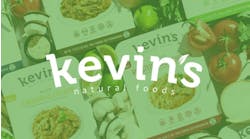When COVID forced people to eat every meal at home and worry if the grocery store would close, the frozen food market thrived. Anxious consumers stocked up on frozen entrees, pizzas, desserts and other goods, driving demand to unprecedented levels.
According to “Power of Frozen in Retail,” a February 2021 report from the American Frozen Food Institute (AFFI), the dollar value of frozen food sales jumped 21% last year and unit sales climbed 13.3%.
“The frozen food aisle has been a growth driver for retailers since 2016 with acceleration ahead of most other departments,” said AFFI President/CEO Alison Bodor in a press release. “Frozen foods are a pandemic powerhouse ringing in $65.1 billion in retail sales in 2020.”
Rastelli Foods Group saw ecommerce sales grow, but had a difficult time getting additional dry ice. So they spent $2 million on equipment to make their own dry ice.
The report also showed that in late 2020, 57% of consumers were still purchasing more frozen foods, 58% were purchasing different kinds of frozen foods, 57% were purchasing different brands than they did pre-pandemic.
“Consumers are both cooking at home more often as well as seeking out convenient, ready-to-eat options, so frozen ingredients and meals are the perfect solutions for these home-bound eaters,” notes Bryan Le, author of "150 Food Science Questions Answered." “There is a lot of excitement in the frozen food sector.”
Rastelli Foods Group, a processor of meat, poultry and fish, found their e-commerce sales of frozen meat and seafood jumped 150% and sales to retailers climbed over 200%, says Mike Kelly, general manager of the company. But that increased demand came with challenges. Many companies, including Rastelli Foods Group, reported that freezing supplies and equipment were suddenly less available.
“For our direct-to-consumer frozen fulfillment center, it was tough to get dry ice, which we rely on to ship orders around the country,” Kelly says. “We ended up investing in $2 million dry ice production equipment so we could make our own dry ice and rely less on availability.”
In addition to that equipment, Rastelli added 45,000 sq. ft. of production space to allow for more storage space for frozen products.
“We have increased our blast freezing capabilities as well, so that we can keep up with the ever-changing demand for orders,” Kelly says.
Rastelli Foods Group is certainly not alone. Many producers scrambled to increase their ability to freeze food during the pandemic, and many companies that manufacture equipment and supplies for freezing recognized the opportunity and stepped up their production. But ultimately they kept retailers’ freezers and consumer pantries well stocked.
Pressure on Frozen Food Equipment/Goods Suppliers
One company that jumped on the frozen food opportunity was Pelton Shepherd, which makes cold chain technology.
“The pandemic made us fasten our seatbelts even tighter than before,” says Tim Shepherd, the company’s CEO and grandson of the founder. “It was a major spike. When everyone had stay-at-home orders, they needed frozen and refrigerated foods more than ever. So we configured our products into that supply chain.”
Among Pelton Shepherd’s products that enjoyed a big bump in sales during COVID was Glacier Ice, which are packets of refrigerant that deliver +30 degree F temperature control in a low-cost, nontoxic, non-caustic formulation; and Curatemp Pro Premium Gel Ice Refrigerant, which ensures temperature accuracy at a number of specific points using a semi-solid nontoxic gel with a neutral pH.
The pandemic gave birth to Enviro Ice, which keeps food frozen and can be recycled as nitrogen-based plant food once it is thawed and diluted with water.
A new product introduced just before the pandemic is Enviro Ice, which keeps food frozen and can be recycled as nitrogen-based plant food once it is thawed and diluted with water. Enviro Ice, which is part of the company’s TerraTemp line, proved especially popular for manufacturers of meal kits.
“Consumers can cut open the Enviro Ice packet and drain it onto household plants or their garden,” Shepherd explains. “Our tests show that consumers can see a 25% increase in color and growth of plants with regular application.”
Another company that benefited from the jump in frozen food sales was ingredient provider Ingredion.
“During the pandemic, in-home eating experienced a surge, and demand increased for our ingredients that go into soups, frozen vegetables and pizza crusts,” says Ron Pagaoa, Ingredion’s senior marketing manager-savory category. He says the company’s development team worked extensively to come up with products that help food manufacturers deliver better frozen food.
“Ingredion’s food scientists work alongside our customers to identify solutions that include gums and other hydrocolloids, such as xanthan gum, guar gum and locust bean gum which are effective in providing freeze-thaw stability in frozen food applications by binding water and managing ice crystal formation," he says. "These types of ingredients work really well in frozen soups, frozen sauces, frozen ready meals, ice cream and other frozen desserts.”
We Pack Logistics, which packs and ships food for manufacturers on a contract basis, did not see a jump in frozen food shipping demand until early this year. Most of their customers handled their frozen food packaging internally during most of the pandemic, but that eventually changed, reports Jeff Edwards, director of opportunity planning and development at We Pack Logistics.
“In the beginning of March we saw a big upsurge in both RFPs for frozen repack and the return of a major customer asking us to go from zero to two shifts in just a matter of a few weeks,” Edwards says. “I think the delay in reorganizing the repack supply chain may have been the result of a certain level of expectation that ‘normal’ would be back by the end of Q1. Instead, it looks like normal may still be several months away.”
Most food processors managed
With the help of companies like Pelton Shepherd, Ingredion and We Pack Logistics – and many others – most food processors successfully handled the increased demand for frozen food.
Jack Acree, executive vice president of Saffron Road Foods, says his company – which produces frozen entrees such as Chicken Pad Thai, Lamb Saag and Chicken Enchiladas Poblano – used their good relations with suppliers to keep up.
Saffron Road Foods saw demand for its frozen ethnic entrees double at certain times during the pandemic.
“Our demand was up 1.5X to 2X at certain times,” Acree says. “But as a smaller company we are more flexible and were able to work with our supplier to remain fully in stock throughout. We brought new production on line and built more inventory in our warehouses. This was not without cost, but it was more than a business decision for us as we also felt a responsibility to keep good nutritious food on the shelf.”
South African plant-based food processor Fry Family Food Co. also managed to keep its frozen products – such as its vegan quesadillas, burgers and sausages – on store shelves.
“When South Africa went into lockdown in March 2020, there was a definite spike in sales as consumers stockpiled,” says Tammy Fry, co-founder and global brand lead for the company. “We believe the increase in demand was driven by the frozen nature of our products, as well as a greater demand for plant-based foods.
"Because we were seen as an essential service business, we were able to operate fairly normally and maintain a fairly robust supply chain," she continues. "We did face some challenges with export and import but there was incredible support from government to ensure the food supply was not interrupted. Our distribution systems, which have always been geared toward frozen goods, were able to maintain some sense of normalcy.”
Future demand
Will frozen food sales continue strong as the COVID pandemic subsides? Adrienne Seiling, senior vice president of strategic communications for AFFI, argues that signs point toward continued strength.
She explains that frozen foods cover all meal times, and with the work-from-home trend likely to continue at some level post-pandemic, demand for convenient meals at home should remain robust. Furthermore, online food sales jumped by 84% in 2020, and frozen foods play a huge role in that category.
Ultimately, though, it may be simply habit that keeps frozen foods flying out of stores. People who tried more frozen during the past year may stick with it.
“Every brand, product or category has three ways to increase sales: having more people buy, having people buy more, and having people buy more often,” Seiling says. “Frozen food sales gains are the result of hitting this growth trifecta. Virtually every frozen food category saw an increase in household penetration, trips and the average basket size - an accomplishment not all departments can boast.”
That evidence shows that food processors in the frozen food space, and the companies that supply the equipment and logistics behind frozen food, should expect continued strong markets.
Says Seiling: “All of these signs point to a bright future for frozen food demand.”


